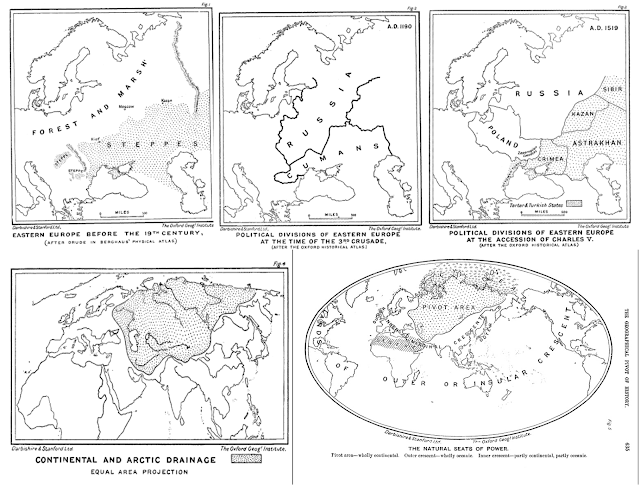The Geographical Pivot of History, sometimes simply as The Pivot of History is a geostrategic theory, also known as Heartland Theory. "The Geographical Pivot of History" was an article submitted by Halford John Mackinder in 1904 to the Royal Geographical Society that advanced his Heartland Theory. In this article, Mackinder extended the scope of geopolitical analysis to encompass the entire globe.
Supported by five diagrams, it was published by the Society in April 1904 together with comments by several students of geography. Probably few who read the lecture in 1904 guessed that Figure 5, bearing the caption "The Natural Seats of Power," would become one of the most famous maps of our time. It embodied one of the most thought-provoking views of the world in the twentieth century and has exercised a profound influence on foreign affairs and on history.
The Heartland consists of Russia and Central Asia (Kazakhstan, Kyrgyzstan, Tajikistan, Turkmenistan, and Uzbekistan)
In the Heartland theory, Mackinder actually engages geography in international politics both literally and figuratively. Literally, the Heartland theory pointed out that, Eurasia is strategically the most advantageous geographical location (See: Figure).
On the other hand, figuratively this theory put emphasis on the centrality of the Eurasian region. Mackinder stated that in the context of the global geopolitical processes, the Eurasian continent is found in the center of the world politics. Under this statement, he suggested that the state that dominated the Heartland would possess the necessary geopolitical and economic potential to ultimately control the world politics. Although the Heartland Theory faced much criticism in the decades since its publication, rather the study aims to just how far the philosophy is rational as well as influential in the contemporary environment of international politics.
He asserted that the European civilization was the product of outside pressure. His account of Europe and European history, regarding it as the result of many centuries of struggle against invasions from Asia, proceeded from the same idea. He believed that Europe’s advance and expansion were stimulated by the need to respond to the pressure coming from the center of Asia. Accordingly, it was the Heartland (where the continental masses of Eurasia were concentrated) that served as the pivot of all the geopolitical transformations of historial dimensions within the World Island.
He pointed out that the Heartland was in the most advantageous geopolitical location. Aware of the relative nature of the conception “central location,” Mackinder pointed out that in the context of the global geopolitical processes, the Eurasian continent is found in the center of the world, with the Heartland occupying the center of the Eurasian continent. His doctrine suggested that the geopolitical subject (actor) that dominated the Heartland would possess the necessary geopolitical and economic potential to ultimately control the World Island and the planet.
Supported by five diagrams, it was published by the Society in April 1904 together with comments by several students of geography. Probably few who read the lecture in 1904 guessed that Figure 5, bearing the caption "The Natural Seats of Power," would become one of the most famous maps of our time. It embodied one of the most thought-provoking views of the world in the twentieth century and has exercised a profound influence on foreign affairs and on history.
The Heartland consists of Russia and Central Asia (Kazakhstan, Kyrgyzstan, Tajikistan, Turkmenistan, and Uzbekistan)
On the other hand, figuratively this theory put emphasis on the centrality of the Eurasian region. Mackinder stated that in the context of the global geopolitical processes, the Eurasian continent is found in the center of the world politics. Under this statement, he suggested that the state that dominated the Heartland would possess the necessary geopolitical and economic potential to ultimately control the world politics. Although the Heartland Theory faced much criticism in the decades since its publication, rather the study aims to just how far the philosophy is rational as well as influential in the contemporary environment of international politics.
He asserted that the European civilization was the product of outside pressure. His account of Europe and European history, regarding it as the result of many centuries of struggle against invasions from Asia, proceeded from the same idea. He believed that Europe’s advance and expansion were stimulated by the need to respond to the pressure coming from the center of Asia. Accordingly, it was the Heartland (where the continental masses of Eurasia were concentrated) that served as the pivot of all the geopolitical transformations of historial dimensions within the World Island.
He pointed out that the Heartland was in the most advantageous geopolitical location. Aware of the relative nature of the conception “central location,” Mackinder pointed out that in the context of the global geopolitical processes, the Eurasian continent is found in the center of the world, with the Heartland occupying the center of the Eurasian continent. His doctrine suggested that the geopolitical subject (actor) that dominated the Heartland would possess the necessary geopolitical and economic potential to ultimately control the World Island and the planet.

.jpg)


No comments:
Post a Comment